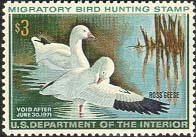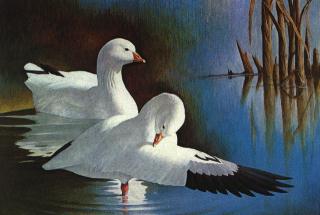

Back to RW37 Back to the Federal Index Home
A LITTLE HISTORY ON THE 37TH (1970-71) DUCK STAMP ARTIST


In his choice of subject, Mr. Bierly had always been partial to the big game of Africa, and particularly to the large cats. Because of his deep concern about the future of these animals, he donated many of his paintings to conservation groups for fund raising auctions. He hopes to spread appreciation for the animals so that their chances for survival and preservation will improve.
One of these works was a painting of Mohini, the splendid white tigress at the National Zoo, and one of her white cubs. The story of the white tigers had always been a fascinating one, shrouded in mystery. The mystique of a few legends and a few skins became much more of a reality when a living specimen was captured by the Maharajah of Rewa in central India in the late 1940's. The white male was named Mohan and was bred twice in 1958 to orange tigers to produce four white cubs. One of these was Mohini, the subject of Mr. Bierly's painting.
After Mr. Bierly finished the painting, he donated a limited edition of 1000 signed and numbered prints to the Smithsonian Institution to be used to raise money to finance a census and study of the remaining Bengal tigers in India. During his visit to Peking to pick up Giant Panda bears, gifts from China, Dr. Theodore Reed, director of the National Zoo, presented prints from this edition to officials of the People's Republic of China. When the two Pandas, Ling Ling and Hsing Hsing came to Washington, Mr. Bierly did the portraits of the famous newcomers.
Mr. Bierly used a design featuring Ross' Geese to win his third Duck Stamp competition. The victory made him one of only three men ever to design three winning Duck Stamps, the others being Stanley Stearns and Maynard Reece. He was the first person to take advantage of the contest rule which allowed full-color entries rather than simple black and white. He had a difficult time deciding whether to do his print in color, like the original and the stamp or in black and white to conform to the rest of the print collection.
He debated the issue carefully and finally decided he must pioneer the break and go to color. He sought out the best talent and facilities to convert his painting into a full-color print. The fine quality of the color print softened the disappointment of those who might have preferred a black and white print. The custom of full-color prints was subsequently established by the later winners.
--------------------THE ART--------------------Ross' Geese was painted in full-color watercolor. The print is by a four color process in photomechanical lithography. The first edition was 700 prints signed and numbered in pencil with 300 remarqued prints signed and numbered in pencil A second edition has been printed. This was Edward Bierly's third win. The image size of the print is 7" x 9 3/4".
--------------------THE STAMP--------------------
Ross' Geese…Engraved by the Federal Bureau of Engraving from the original artwork. Printed in yellow, red, blue, green and black ink. The stamp sold for three dollars. Postal records show 2,320,244 stamps sold. First day of sale was July 1, 1970.
Most of the information contained above is from the book Federal Duck Stamp Story, Fifty Years of Excellence, by Laurence F. Jonson; Alexander & Co. It is used here with permission from the author. For more information on this book, please click here.